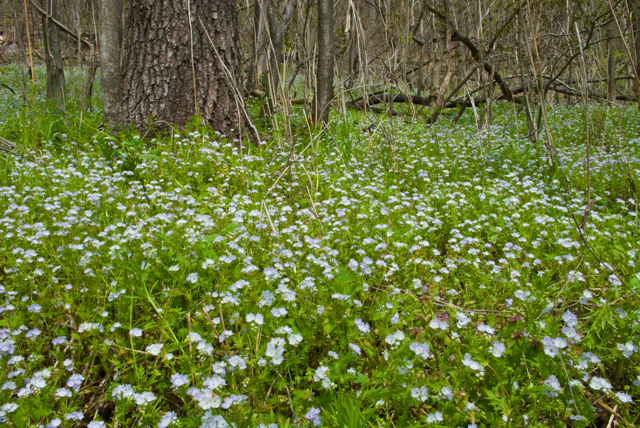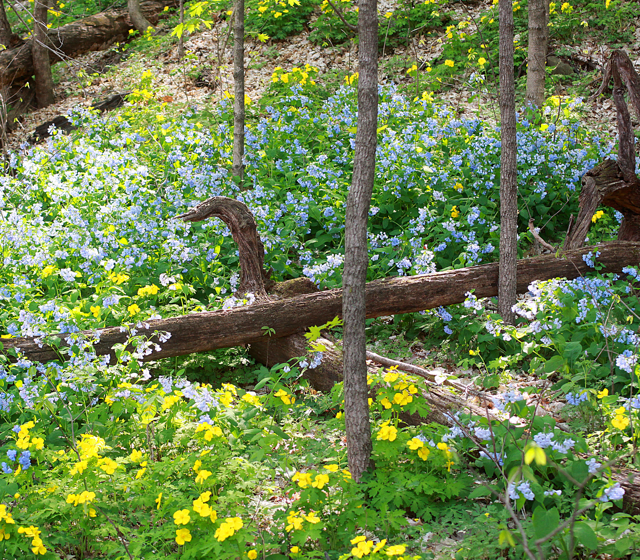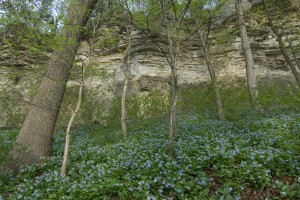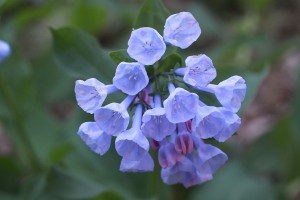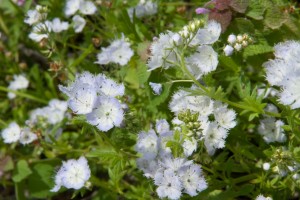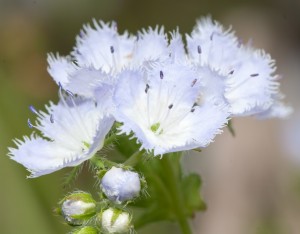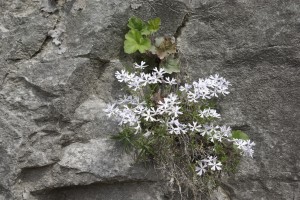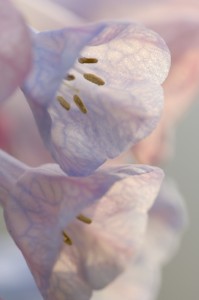April: Not At All the Cruelest Month…
April is a wonderful month to view the dynamic and beautiful natural processes at work in our bluff lands. Our still leafless woods allow us to see the physical structure and layout – the skeleton – of one of Illinois’s most important natural treasures. A simple driving tour along Bluff Road, from Columbia to Modoc, is an easy way to begin to understand the complex inter-workings of the bluff landscape. While hill prairies still wear their winter brown colors up on the tops of the bluffs, the area below has begun to blossom with color that resembles the sky.
The limestone bedrock cliff face of the bluffs is constantly subjected to the forces of nature. Seasonal temperature changes, and the actions of rain, rainwater runoff, wind and sun – cumulative actions called weathering – combine to loosen rock material from the cliff face. The rocky materials, ranging in size from tiny grains to huge boulders, fall, slide, or roll off the cliff to the foot of the bluff.
An apron of rock waste sloping downward from the foot of the cliff face accumulates. This area, from the base of the cliff to the edge of Bluff Road is called a talus (pronounced “tay-less”) slope.
Once a rock has fallen and come to a stop the processes of weathering continue. Boulders and larger rocks are slowly reduced to smaller and smaller stones and grains. And, over time, these smaller aggregates creep further down the slope.
In fact, the talus slope is an ever-changing geological and ecological system. Drier, rockier shallow soils lay at its head, near the cliff, with thicker, more moisture retentive soils at the toe, right along Bluff Road. Plant life in the talus manifests this dynamic moisture and soil-depth gradient from head-to-toe on the slope.
Near the cliff face at the top of the slope, Chinquapin and Post
Oak trees predominate. They readily tolerate the rocky and dry soils along the head of the talus. Along the mid-slope, White and Black Oaks, Ash and Hackberry trees thrive in the slightly deeper, but still thin, soils. Evidence of their unstable footing in constantly downward moving soils shows in the backward-leaning, curved main stems of these trees. Sugar (Hard) Maple, native to the one-time adjacent flood plain forest, and Ohio Buckeye trees dominate the area along the toe of the talus slope.
The shady, seemingly inhospitably rocky soils of the talus slope also host a number of wildflowers. In spring, before leafout of the forest canopy, two wildflowers of extreme beauty – both as individual flowers and as broad carpets of color – decorate the talus slope. A third wildflower grows along the head of the talus and even clings to the sheer rock walls above. Shimmering blue in the spring sun, colonies of each type seem like bits of sky brought to earth and each predominates in a distinct area of our bluffs.
Between Columbia and Old Valmeyer, swathes of Virginia Bluebells (Mertensia virginica) bloom along the talus slope. Pockets of dense, expansive colonies of the two-foot tall-stemmed plants occur along streams and in low, shaded areas, and line portions of the talus north of Valmeyer. The more westerly aspect of the bluff line in this area creates a less sun-filled, and so more moisture-retentive and slightly cooler, microclimate in which the bluebells flourish.
The tubular-shaped intensely blue flowers age slowly into
lavender-pink shades and are among the most dramatic blossoms in the springtime bluffs. Often likened to bits of sky fallen to earth, bluebells delight the eye with their early spring exuberance. The drama, however, is short-lived. By June the plants completely disappear and remain dormant until the following spring.
South of Old Valmeyer, where the bluff line takes on a hotter, more consistently sunny southern aspect, swathes of another blue flower brighten the spring on our talus slopes. Miami Mist (Phacelia purshii) comes into bloom in late April to May. These foot-tall plants also form dense carpets of color. Each pale blue to lavender flower is small, only one-half inch across, with a white center and each of the five petals boasts a
distinct delicately fringed margin. Euro-American settlers in the Miami Valley region of Ohio who saw the hillsides foaming with the rich tapestry of pale blue flowers gave this plant its common name. Like the bluebells, Miami Mist disappears shortly after blooming, leaving little trace of its pleasing presence among the sun-baked summer grasses near Bluff Road.
While scattered patches of Cleft Phlox (Phlox bifida) bloom all along the talus of Monroe and Randolph Counties, this plant truly comes into its own and predominates the blooming story of spring from Prairie du Rocher to Modoc. The aspect of the bluffs and talus slope do not explain the predominance of Cleft Phlox and the near-absence of the other two “sky-flowers” in this area. From just north of Prairie du Rocher, the bluffs and the talus slope exhibit a different form and structure. The bluff face is less high, but is generally very steep and sheer and has a minimal apron of talus slope. The soils are very thin and rocky and quickly allow moisture to drain away. The rock structure in this area is primarily cherty sandstone.
The very drought-tolerant Cleft Phlox forms mats, stretching
wiry stems along the ground and into rock crevices. Only six inches tall, the plants are covered in early spring with luminous pale blue to lavender flower heads, with each of the five petals deeply notched at the tip. The fragile appearance of the delicate flowers is, however, belied by the plants’ favored growing conditions: high on the dry soils of the talus head and up onto the rocks of the cliff face. Cleft Phlox also goes dormant soon after blooming, leaving only thin stems and parched leaves until next year’s early spring sun again brings them to shine like patches of sky tossed down upon the rocks.
While granting many opportunities to admire the stretches of wildflowers that decorate our bluff lands with a sky-hued tapestry from north to south, a drive along Bluff Road also shows large areas where wildflowers no longer grow. Dense stands of Tree-of-Heaven (Ailanthus altissima) now dominate entire stretches of the talus slope and have turned the diverse plant communities into broad deserts of a single, alien species.
This native of China was introduced as an ornamental tree in the nineteenth century. It grows rapidly and spreads through both tremendous seed production and by root sprouts. Dense thickets formed by Tree-of-Heaven quickly out-shade and out-compete other plants. The tree roots produce toxins that poison and prevent the establishment of other plant species. The droughty, rocky soils of our talus slopes unfortunately provide the very growing conditions under which this tree can thrive and spread.
During late winter and spring several of these areas with extensive Tree-of-Heaven infestation have undergone control methods. Girdling and herbiciding of the trees will reduce the population and continued seed production. Full control methods, however, will take years of efforts because the seeds remain viable and small root sprouts may continue to occur.
The control efforts have been funded through innovative cost-share programs between the U.S. Fish and Wildlife Service and the State of Illinois. This State Wildlife Grant (SWG) project and the Landowner Incentive Program (LIP) specifically target Hill Prairies and their associated woodlands and are designed to enhance both public and privately owned sites within this significant and very rare ecosystem. The work includes exotic plant control, brush removal, prescribed burning and seed collecting and planting.
Such programs benefit our area and our area’s unique
geological and ecological systems. They will help ensure that “sky-flowers” bloom in future spring times, that the nearby woods are brightened with dogwood flowers dancing on air, and that the hill prairies will be, once again, ablaze with summer coneflowers and orange bunch grasses.
Clifftop, a local nonprofit organization, is focused on preserving and protecting area bluff lands.
Versions of this article appeared in the April 3 2009 edition of the Monroe County Independent and in the April 15 2009 edition of the Suburban Journals Clarion Enterprise.
© 2009 all content rights reserved, Clifftop NFP.
Comments are currently closed.

